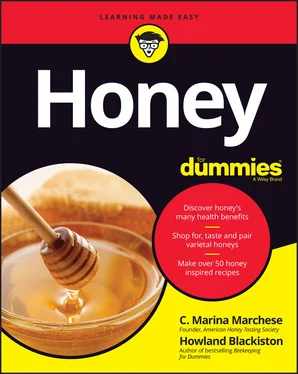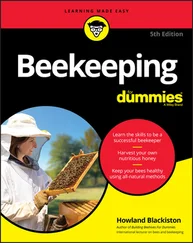Housekeeping (Days 1 to 3): A worker bee is born with the munchies. Immediately after she emerges from the cell and grooms herself, she engorges herself with bee bread (pollen) and honey. Following this binge, one of her first tasks is cleaning out the cell from which she just emerged. This cell and other empty cells are cleaned and polished and left immaculate to receive new eggs or to store nectar and pollen.
Undertaking (Days 3 to 16): The honey beehive is one of the cleanest and most sterile environments found in nature. Preventing disease is an important early task for the worker bee. During the first couple weeks of her life, the worker bee removes any bees that have died and disposes of the corpses as far from the hive as possible. Similarly, diseased or dead brood are quickly removed before becoming a health threat to the colony.
Working in the nursery (Days 4 to 12): The young worker bees tend to their baby sisters by feeding and caring for the developing larvae. On average, nurse bees check a single larva 1,300 times a day. The number of days spent tending brood depends on the number of brood in the hive and the urgency of other competing tasks.
Attending royalty (Days 7 to 12): Because her royal highness is unable to tend to her most basic needs by herself, some of the workers do these tasks for her. They groom and feed the queen and even remove her excrement from the hive. These royal attendants also coax the queen to continue to lay eggs as she moves about the hive.
Stocking the pantry (Days 12 to 18): In the hive, worker house bees take nectar or pollen from foraging field bees returning to the hive. These bees deposit the pollen and nectar into cells earmarked for this purpose.To the pollen, they add nectar and their saliva, which contains enzymes that inoculate the pollen with natural probiotic bacteria and the yeasts and sugars necessary to jumpstart the fermentation of pollen into the highly nutritious and protein rich beebread.To the nectar, they add saliva (enzymes) and set about fanning the nectar cells continuously to reduce the water content, eventually turning the watery nectar into thick, sweet, ripened honey with a moisture content of 17–18 percent.
Fanning (Days 12 to 18): Worker bees also take a turn at controlling the temperature and humidity of the hive. During warm weather they fan furiously at the hive’s entrance to draw air into the hive. Additional fanners are in position within the hives. In addition to cooling the hive, the fanning hastens the evaporation of excess moisture from the curing honey.
Becoming architects and master builders (Days 12 to 35): Worker bees that are about 12 days old are mature enough to begin producing beeswax. These white flakes of wax are secreted from wax glands on the underside of the worker bee’s abdomen. They help with the building of new wax comb and in the capping of ripened honey and brood cells containing developing pupae.
Guarding the home (Days 18 to 21): The last task of a house bee before she ventures out is that of guarding the hive. At this stage of maturity, her sting glands have developed to contain an authoritative amount of venom. You can easily spot the guard bees at the hive’s entrance. They are poised and alert, checking each bee that returns to the hive for a familiar scent. Only family members are allowed to pass.
Field bees (Days 21 till death): When the worker bee is a few weeks old, she ventures outside the hive to perform her last and perhaps most important job — to collect the pollen and nectar that will sustain the colony. With her life half over, she joins the ranks of other field bees until she reaches the end of her life, some three weeks later.
Understanding the Composition of Honey
Honey is the sweet result of the bees magically transforming the nectar they gather from flowers. Honey is about 80 percent fructose and glucose, and between 17 and 18 percent water. Maintaining a balance between sugar and water is critical to the quality of honey. Excess water, for example from poor storage, can trigger yeast fermentation, causing the honey to spoil. The bees nail this balance instinctually, but we can upset the delicate ration by improper harvesting and storing of honey.
More than 20 other sugars can be found in honey, depending upon the original nectar source. There are also proteins in the form of enzymes, amino acids, minerals, trace elements, and waxes. The most important enzyme is invertase, which is an enzyme added by the worker bees. This is responsible for converting the nectar sugar sucrose into the main sugars found in honey: fructose and glucose. It is also instrumental in the ripening of the nectar into honey.
With an average pH of 3.9, honey is relatively acidic, but its sweetness hides the acidity.
The antibacterial qualities associated with honey come from hydrogen peroxide, which is a by-product of another enzyme (glucose oxidase) introduced by the bees.
The plants themselves and the soil they grow in contribute to the minerals and trace elements found in honey. See Figure 2-3 for a typical breakdown of honey content.

Illustration by Howland Blackiston
FIGURE 2-3:This chart illustrates the typical content of honey (based on data from the USDA).
HMF (hydroxymethylfurfural) is an organic substance naturally found in all honeys. In the lab, it is used as a marker to prove the honey is raw, unheated, and it has not been stored for an excessive period of time. Freshly extracted honey displays HMF levels lower than 5 mg/kg. Levels higher than this indicate the honey may be old, overheated, or poorly stored. While the average customer may not necessarily taste the difference in honeys with high HMF levels, experienced honey tasters do.
In the European Union, non-tropical origins cannot exceed HMF limits of 40 mg/kg, and tropical origins must have a maximum HMF limit of 80 mg/kg. Honeys with HMF values above these limits are considered as “industrial honeys” and cannot be sold for direct consumption but as baker’s honey (acceptable for use in baking and as an ingredient in commercial food processing) only.
There are no formal HMF limits legally established in the United States, although some beekeepers and commercial honey packers do follow the EU directive.
Honey owes its delicate aromas and flavors to the various volatile substances (similar to essential oils) that originate from the flower. As age and excess heat decompose the fructose, hydroxymethylfurfural (HMF) naturally found in all honeys increases, thus lowering the quality of the honey. (see sidebar, “What is HMF?”). Each of these components that make up honey is extremely fragile, and overheating honey or improper or long-term storage can compromise not only the healthful benefits but also honey flavors as well as darken the color.
Harvesting Honey: From Bee to Bottle
Whether you get your honey from a local beekeeper or a commercially available source, the process of harvesting honey is similar. Only the scale of operations differs.
Another difference in harvesting is the “style” of honey that’s going to market. There are four major styles of honey, and the differences mostly have to do with how the honey is presented to the public:
Still in the wax comb
As a liquid extracted from the comb
As a combination of the preceding two
Whipped or creamed into a smooth, spreadable product
See Chapter 3for more details.
How these styles of honey are harvested differ, but since here in the United States there is more extracted liquid honey sold than any other style, I use that as the example in the following sections.
Читать дальше













